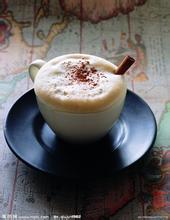Main coffee varieties and their characteristics Characteristics of estate beans
Cartimo (Catimor)
Born in Portugal in 1959, Timor (Alabica and Robsta) with strong leaf rust was mated with bourbon mutant Kaddura. Among the high-yield commercial varieties, it has the best growth length and the highest yield. the tree height is low and the coffee fruit and seeds (raw beans) are on the large side. There are quite a number of new varieties derived from Cartimo. The varieties of the Katimer series are strong, adaptable to the environment and high yield. but in terms of taste, the low-real-estate Cartimo is not far different from other commercial varieties, but the Katimo produced at an altitude of more than 1200 meters is obviously at a disadvantage compared with Bourbon, Kaddura, Kaduai and so on.
Mutant Columbia (Variedad Colombia)
A highly disease-resistant variety produced by mating between Cartimo and Kaddura. It is resistant to direct sunlight and can be harvested in a short time. Colombia began to plant widely in the 1980s, replacing the inherent variety Tibica as the main breed. Generally speaking, Arakabi coffee trees represented by Tibica must have shading trees for it, but variants of Colombian coffee trees with 1/4 Robusta lineages do not need shelter trees. It can be produced and harvested all year round. However, in recent years, coffee beans may emit Phenol (odor similar to iodine) due to the influence of pesticides or chemical fertilizers. The difference with the inherent variety Tibica can be seen at a glance through deep city roasting (Full-city roasting). Generally, coffee will become sour and bitter after roasting in deep cities. After the second bursting period, the bitterness of the mutant Colombian coffee increases sharply.
Excerpt (Coffee Daquan) Guard Taguchi. Author & Wikipedia
There are mainly two kinds of coffee on the market, such as Coffea Arabica and Coffea Robusta. Each of them can be subdivided into more variety branches. On the other hand, most of the coffee beans in circulation on the market distinguish Catuai by their origin.
The mating species of mundo Novo and Kaddura (Caturra). High yield and environmental adaptability, tree height (because the tree height is too high, which makes it difficult to harvest, so it will mate with the tree height Kaddura). Unlike Kaddura, Kaddura bears fruit year after year. Although it must be fully fertilized, it is resistant to diseases and insect pests And the fruit is not easy to fall in the face of strong wind and rain. only the fruit growth and harvest life is only about ten years, and its short life span is its weakness. it is mainly cultivated in the vast area from Colombia to Central America. Kaduai's taste is more monotonous and lacks mellow thickness.
Marago Gippe (Maragogype)
This is a Tibica mutant found in Brazil. the beans are large and need to be filtered with a sieve of more than 19 sieves. the taste is poor and the appearance is good, so it is favored by some markets. The tree is high, so the yield is low.
Kent (Kent)
A variety from India with high yield and strong resistance to diseases, especially leaf rust. It is considered to be a hybrid of Tibika and other varieties.
Amaret O (Amareiio)
Generally speaking, the fruit of coffee appears red when it is ripe, but the fruit of this variety is just like its name (Amareiio comes from the modern Latin Amareiius-, which means "yellow"), and the fruit is yellow when it ripens. The tree is high, so the yield is high.

Important Notice :
前街咖啡 FrontStreet Coffee has moved to new addredd:
FrontStreet Coffee Address: 315,Donghua East Road,GuangZhou
Tel:020 38364473
- Prev

What kind of equipment should I use for Jamaican Blue Mountain Coffee beans?
Jamaican Blue Mountain Coffee belongs to the category of single bean coffee, also known as regional coffee, which refers to the special coffee produced by unique factors such as climate and altitude in some places. This kind of coffee tasting method is the most suitable for siphon pot, which can show the flavor of coffee in the most comprehensive way. The siphon pot is classic in design and easy to operate. The extraction is comprehensive. It is the most frequently used appliance for household use or individual product appreciation.
- Next

Indonesia's main coffee producing area
Mandheling, produced in Sumatra mountains, is world famous and rich in texture. Sumatra and East Africa's wine-like taste contrast, Indonesia and New Guinea beans show a different flavor, with a sticky texture, acidity buried deep in the complex taste, dark and intense herbal or wild mushroom flavor, and deep throat three days around the back of the sweet
Related
- Detailed explanation of Jadeite planting Land in Panamanian Jadeite Manor introduction to the grading system of Jadeite competitive bidding, Red bid, Green bid and Rose Summer
- Story of Coffee planting in Brenka region of Costa Rica Stonehenge Manor anaerobic heavy honey treatment of flavor mouth
- What's on the barrel of Blue Mountain Coffee beans?
- Can American coffee also pull flowers? How to use hot American style to pull out a good-looking pattern?
- Can you make a cold extract with coffee beans? What is the right proportion for cold-extracted coffee formula?
- Indonesian PWN Gold Mandrine Coffee Origin Features Flavor How to Chong? Mandolin coffee is American.
- A brief introduction to the flavor characteristics of Brazilian yellow bourbon coffee beans
- What is the effect of different water quality on the flavor of cold-extracted coffee? What kind of water is best for brewing coffee?
- Why do you think of Rose Summer whenever you mention Panamanian coffee?
- Introduction to the characteristics of authentic blue mountain coffee bean producing areas? What is the CIB Coffee Authority in Jamaica?

